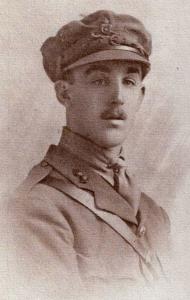
|

|
| Lieutenant John Philip Morton CARPENTER | |
|
5th (Service) Battalion Wiltshire Regiment and B Battery, 187th Brgade, Royal Field Artillery Date of birth: 4th August 1893 Date of death: 15th September 1916 Killed in action aged 23 Buried at Bulls Road Cemetery Flers Plot III Grave L Row 14 |

|
| John Philip Morton Carpenter was born at 2 The Close, Salisbury in Wiltshire on the 4th of August 1893 the second son of Archdeacon Henry William Carpenter OBE, Archdeacon of Sarum, a former assistant master at Lancing from 1875 to 1879, and Annie Susanna (nee Morton) Carpenter of North Canonry, 20 The Close, Salisbury in Wiltshire. He was educated at Marlborough College from September 1907 to December 1909 and at Lancing College where he was in News House from January 1910 to April 1912 where he was a member of the Officer Training Corps. On leaving school he studied agriculture. Following the outbreak of war he applied for a commission in the Army Service Corps on the 18th of August 1914 in an application which was supported by the Reverend Bowlby, headmaster of Lancing College. He underwent a medical examination at Devizes on the 13th of August 1914 where it was recorded that he was six feet and one quarter of an inch tall and that he weighed 152lbs. Unable to wait for his commission to come through he enlisted at Salisbury as Private 4603 in the 20th (Service) Battalion Royal Fusiliers (City of London Regiment) University and Public Schools Corps on the 12th of September 1914. He underwent a further medical examination on the same day where it was recorded that he had a fair complexion, green eyes and fair hair. He was commissioned as a 2nd Lieutenant in the Wiltshire Regiment on the 22nd of September 1914. On the 3rd of August 1915 the 5th Battalion Wiltshire Regiment embarked on board the HMT “Sania” at Mudros for a second tour at Gallipoli. They landed the following morning and occupied reserve trenches at Walker’s Ridge and on the 10th they were involved in an advance up the hill at Chunuk Bair in support of an attack. They were caught in the open and according to one account three companies were “annihilated”. The survivors withdrew to the beach in small parties where they regrouped. On the 11th of August John Carpenter was wounded while on the beach and was evacuated back to England. Following his recovery he transferred to the 187th Brigade, Royal Field Artillery with the rank of Lieutenant on the 10th of October 1915. He was married at Salisbury Cathedral at 2pm on the 4th of December 1915 to Marjorie Clare (nee Ord). He went with his Brigade to France from Southampton at 5.40pm on the 2nd of May 1916, landing at Le Havre at 11am the following morning. On evening of the 15th of September 1916 he was reconnoitring for a new position for his battery following the capture of the village of Flers earlier in the day. While talking to his Battery Commander, Major Heneage Frank Stopford who had recently taken command, a shell landed killing them both and wounding three gunners. His wife received a telegram dated the 20th of September 1916: - "Deeply regret to inform you that Lieut. J.P.M. Carpenter RFA was killed in action September 15th. The Army Council express sympathy." He "was buried in a shell hole by old battery positions and west of German wire, between Longueval and Flers." but his body was exhumed and moved to its present site in 1919. A former Battery Commander wrote:- "He came to me as my Senior Subaltern just before leaving England in May, and was my most valued officer. He will be a loss to the Battery indeed. He worked very hard, and was a great help to me in France." His widow applied for his medals in March 1921. He is commemorated on the war memorial at Marlborough College and on the Roll of Honour at Salisbury Cathedral. |
|
| News House |
Back